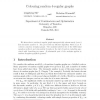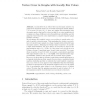26 search results - page 4 / 6 » The t-Improper Chromatic Number of Random Graphs |
KDD
2012
ACM
11 years 9 months ago
2012
ACM
We study a novel clustering problem in which the pairwise relations between objects are categorical. This problem can be viewed as clustering the vertices of a graph whose edges a...
CPC
2007
13 years 7 months ago
2007
In a previous paper we showed that a random 4-regular graph asymptotically almost surely (a.a.s.) has chromatic number 3. Here we extend the method to show that a random 6-regular...
CPC
2007
13 years 7 months ago
2007
We show that a random 4-regular graph asymptotically almost surely (a.a.s.) has chromatic number 3. The proof uses an efficient algorithm which a.a.s. 3colours a random 4-regular ...
ICALP
2011
Springer
12 years 10 months ago
2011
Springer
In [13], Erd˝os et al. defined the local chromatic number of a graph as the minimum number of colors that must appear within distance 1 of a vertex. For any ∆ ≥ 2, there are ...
COMBINATORICA
2008
13 years 7 months ago
2008
A random geometric graph Gn is constructed by taking vertices X1, . . . , Xn Rd at random (i.i.d. according to some probability distribution with a bounded density function) and...



